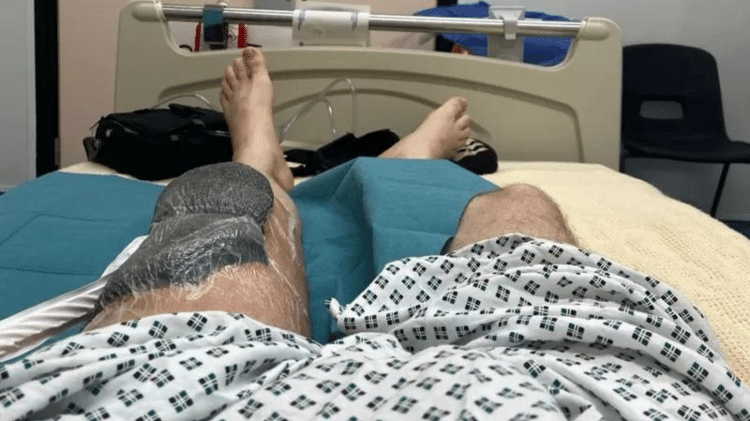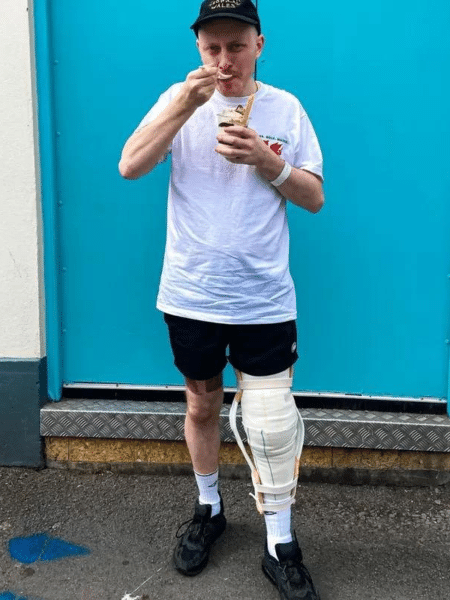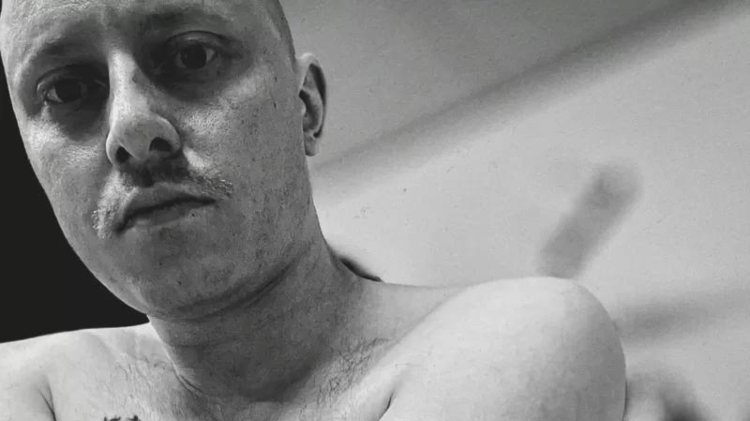British Scott Neil paid little attention to the scrape on his knee when he fell on his way home from work. What he didn’t know was that the injury would almost cost him his life.
“After a few days (without the fall) I realized that something was wrong,” he told the BBC. “By the end of that day, my leg had almost doubled in size, it was so swollen.”
DJ, 31, was hospitalized for more than six weeks and had to undergo six surgeries because the cut caused a very rare but potentially deadly disease: necrotizing fasciitis.
“(The infection) basically ‘eaten’ my muscles and knee,” he says.
Known for releasing toxins that have the ability to “eat” human tissue under the skin, the disease develops in cases of wound infection and, according to the British public health system (NHS, abbreviation), must be treated immediately by doctors. English).
Symptoms that can occur within a few days or even hours include intense pain (more than you would attribute to the wound itself) and loss of feeling around the wound; skin swelling, fever, headache and tiredness.
These symptoms can progress to vomiting and diarrhea, mental confusion, and dark blisters on the skin.
Scott says it’s “chilling” for a cut to have such serious health effects.
Did the doctors who treated him say he was a few hours away from losing his leg? and maybe life. This is because the infection can quickly contaminate the blood, causing sepsis and organ failure.
That’s why experts explain that early detection can be the difference between life and death.
‘Suffering’
Scott recalls “crying in pain” and “begging to be taken to the hospital” a few days after his fall in May of last year.
He even passed out in the hospital, that was the pain he felt.
“I couldn’t believe what happened,” says DJ. “It was the strongest pain I’ve ever felt in my life.”
He needed an operation to remove the necrotic tissue and repair the wounds.
First, doctors used Scott’s back muscles to replace the dead tissue in his leg, but there wasn’t enough blood flow to keep this spare tissue alive.
It was then necessary to use part of the calf to restore the knee.
“It was so hard, I cried a lot when I looked at my body and found it completely different,” Scott recalls.
How does such an aggressive infection develop?
“Scott was very unlucky,” says Dr Marina Morgan, one of the UK’s leading experts on the subject.
“For necrotizing fasciitis to develop, the microbe must be ready to enter the body and have a way of scratching it. If the immune system is weak or they have never encountered this microbe before, they will not have antibodies to fight it,” explains the expert.
Morgan points out that the microbe that causes the worst kind of necrotizing fasciitis is the same microbe that causes childhood tonsillitis.
“People can become immune because they’ve had contact with the germ in childhood tonsillitis before, which isn’t a big deal. So these kids grow up with antibodies and never get sick (with fasciitis).
Morgan says the main sign is very sharp, excruciating pain that is out of proportion to the injury itself.
“This means that the microbe has entered the tissue,” he adds.
If the pain is not relieved by analgesics, doctors should evaluate the possibility of necrotizing fasciitis and treat it with antibiotics. One problem, he says, is that not everyone knows enough about the disease.
Did Doreen Cartledge lose her 23-year-old son, Lee Spark, to necrotizing fasciitis in October 1999 and set up a foundation in his name? The only support group in the UK for people and families affected by such serious infections.
“Very little is known about it among the general public and the mortality rate is high,” he says.
Among survivors like Scott, “many people suffer from PTSD, so it’s important to be aware of the symptoms as early detection and treatment are crucial.”
Recovery
In Scott’s case, the physical and psychological suffering, according to him, was immense. However, this caused him to start looking at life in a different, more optimistic way.
Today, more than a year after being hospitalized and sessions of intense exercise and physical therapy, she is able to walk normally and “do whatever she wants”.
“I remember those busy nights in the ward (hospital) where I lost my grandmother, it was traumatic in itself,” she says.
But “mainly I had to be strong for my family. In a way, I’m grateful for the experience because it taught me to deal with trauma, to face it. I buried all the trauma I had (up until then). I’m grateful for this opportunity. Being able to walk my dog, skate, play football” he adds.
*Reported by Shazia Ali of BBC News
– This text was published at https://www.bbc.com/portuguese/geral-62369395.
source: Noticias
[author_name]



